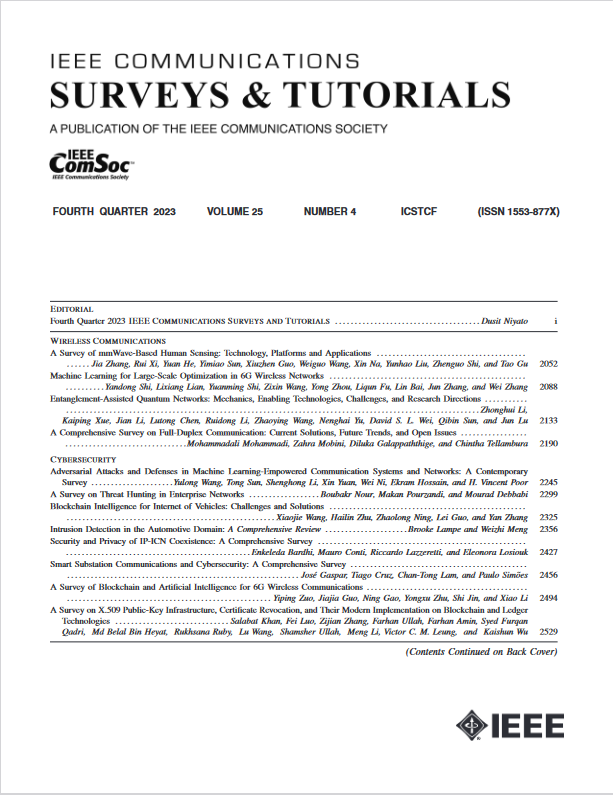5G及以后灵活无线接入网络的低层功能分裂的表征和建模教程
IF 34.4
1区 计算机科学
Q1 COMPUTER SCIENCE, INFORMATION SYSTEMS
引用次数: 2
摘要
无线电接入网(RAN)中基带(BB)功能向数据处理中心的集中正受到越来越多的关注,因为它能够利用多个小区之间的资源池和统计多路复用收益,促进了不同功能(例如,干扰协调)的协作技术的引入。更有效地处理第五代(5G)新无线电(NR)物理层先进功能的复杂要求,例如使用大规模多输入多输出(MIMO)。然而,决定功能分割(即,哪些BB功能保持在无线电单元附近,哪些BB功能是集中的)需要在集中的好处和在分布式天线和数据处理中心之间传输数据的前传成本之间进行权衡。在标准化论坛、研究项目和研究中已经做了大量的研究工作来解决这种权衡,当根据RAN的当前条件动态实现功能分裂的选择时,这种权衡变得更加复杂。本文介绍了灵活无线局域网中功能分裂的表征、建模和评估的综合教程,为5G及以后系统中动态功能分裂优化算法解决方案的未来发展奠定了坚实的基础。首先,本文探讨了不同行业论坛所考虑的功能分裂方法,分析了它们在术语上的等价和差异。其次,本文对物理层的不同BB函数和文献中提出的相关算法解决方案进行了协调分析,评估了计算复杂性和相关性能。在此基础上,提出了一种评估不同功能分组计算需求和前传带宽需求的模型。最后,该模型被用来得出说明性的结果,这些结果确定了在选择功能分割和影响需求的关键元素时出现的主要权衡。本文章由计算机程序翻译,如有差异,请以英文原文为准。
A Tutorial on the Characterisation and Modelling of Low Layer Functional Splits for Flexible Radio Access Networks in 5G and Beyond
The centralization of baseband (BB) functions in a radio access network (RAN) towards data processing centres is receiving increasing interest as it enables the exploitation of resource pooling and statistical multiplexing gains among multiple cells, facilitates the introduction of collaborative techniques for different functions (e.g., interference coordination), and more efficiently handles the complex requirements of advanced features of the fifth generation (5G) new radio (NR) physical layer, such as the use of massive multiple input multiple output (MIMO). However, deciding the functional split (i.e., which BB functions are kept close to the radio units and which BB functions are centralized) embraces a trade-off between the centralization benefits and the fronthaul costs for carrying data between distributed antennas and data processing centres. Substantial research efforts have been made in standardization fora, research projects and studies to resolve this trade-off, which becomes more complicated when the choice of functional splits is dynamically achieved depending on the current conditions in the RAN. This paper presents a comprehensive tutorial on the characterisation, modelling and assessment of functional splits in a flexible RAN to establish a solid basis for the future development of algorithmic solutions of dynamic functional split optimisation in 5G and beyond systems. First, the paper explores the functional split approaches considered by different industrial fora, analysing their equivalences and differences in terminology. Second, the paper presents a harmonized analysis of the different BB functions at the physical layer and associated algorithmic solutions presented in the literature, assessing both the computational complexity and the associated performance. Based on this analysis, the paper presents a model for assessing the computational requirements and fronthaul bandwidth requirements of different functional splits. Last, the model is used to derive illustrative results that identify the major trade-offs that arise when selecting a functional split and the key elements that impact the requirements.
求助全文
通过发布文献求助,成功后即可免费获取论文全文。
去求助
来源期刊

IEEE Communications Surveys and Tutorials
COMPUTER SCIENCE, INFORMATION SYSTEMS-TELECOMMUNICATIONS
CiteScore
80.20
自引率
2.50%
发文量
84
审稿时长
6 months
期刊介绍:
IEEE Communications Surveys & Tutorials is an online journal published by the IEEE Communications Society for tutorials and surveys covering all aspects of the communications field. Telecommunications technology is progressing at a rapid pace, and the IEEE Communications Society is committed to providing researchers and other professionals the information and tools to stay abreast. IEEE Communications Surveys and Tutorials focuses on integrating and adding understanding to the existing literature on communications, putting results in context. Whether searching for in-depth information about a familiar area or an introduction into a new area, IEEE Communications Surveys & Tutorials aims to be the premier source of peer-reviewed, comprehensive tutorials and surveys, and pointers to further sources. IEEE Communications Surveys & Tutorials publishes only articles exclusively written for IEEE Communications Surveys & Tutorials and go through a rigorous review process before their publication in the quarterly issues.
A tutorial article in the IEEE Communications Surveys & Tutorials should be designed to help the reader to become familiar with and learn something specific about a chosen topic. In contrast, the term survey, as applied here, is defined to mean a survey of the literature. A survey article in IEEE Communications Surveys & Tutorials should provide a comprehensive review of developments in a selected area, covering its development from its inception to its current state and beyond, and illustrating its development through liberal citations from the literature. Both tutorials and surveys should be tutorial in nature and should be written in a style comprehensible to readers outside the specialty of the article.
 求助内容:
求助内容: 应助结果提醒方式:
应助结果提醒方式:


